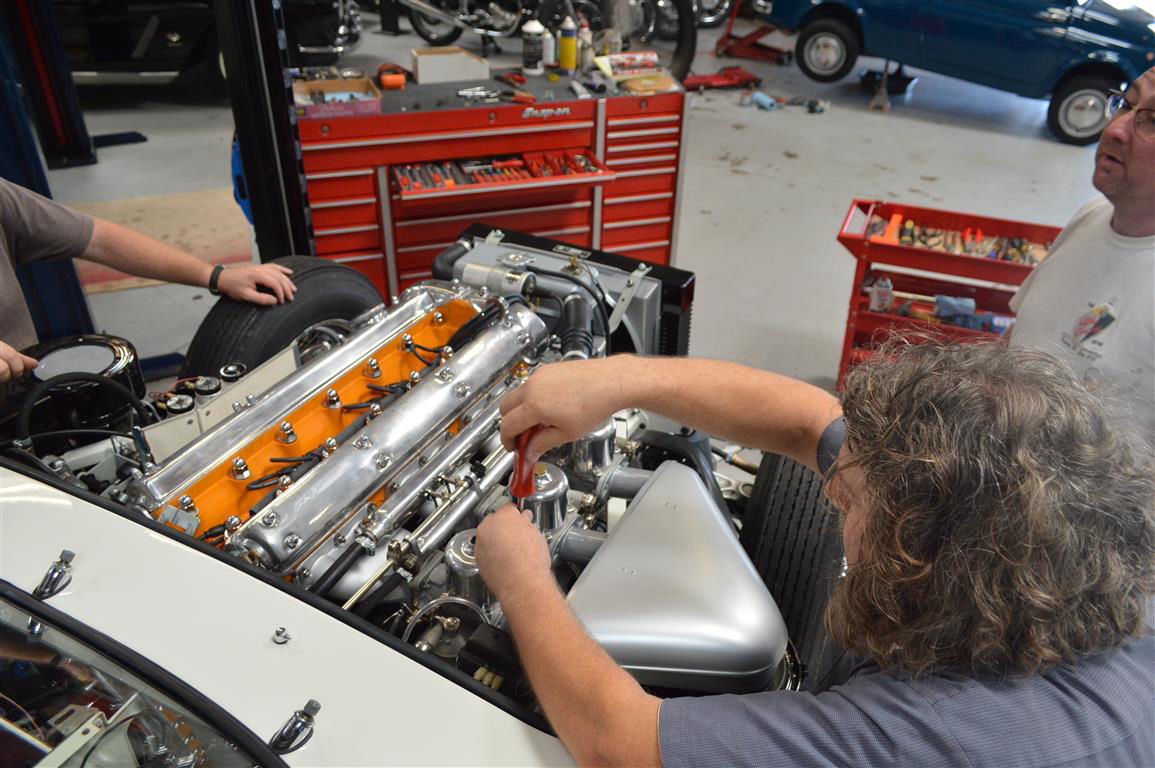
A show level car is a
99 + point or better vehicle. These vehicles are generally not driven
more than a few miles a year and found in a museum or collection. They
may also be found in a climate controlled facility and transported in an
enclosed trailer to Concours and car shows. All components are original
or an exact replacement. Classic Showcase does their utmost to locate
NOS (new old stock) parts for every vehicle. If a specific part is no
longer available in NOS, we source the best aftermarket parts available.
This level of nut and bolt restoration may
be daunting to most companies; however, Classic Showcase’s top
specialists have the experience and expertise to complete these projects
successfully. With our knowledge of the rules and regulations in judged
events, we are able to provide unsurpassed work and craftsmanship with
the proper restorations and reconstruction of our cars.
To begin, you must use the best original car as
possible to achieve the best results. The more originality the car has
the better it will turn out. A lot of pre-planning has to occur before
beginning the project. This requires very precise workmanship through
the whole project and keen attention to detail.
Similar to our other levels of restoration,
we start all our projects with a complete and comprehensive evaluation.
We research the vehicles history and check for any and all documentation
we can find. We carefully look the vehicle over, noting what is
original, what has been altered or what is not working, and what is
missing. We start to assess the overall condition and document it with a
complete set of photographs and notes. After doing various extensive
tests and evaluation inspections on the vehicle, we then start the
disassembly of the vehicle, again taking note of all parts and listing
what will need replacing, restoring, or repairing, also making note of
originality as we proceed.

The interior,
including panels, dash, seats, and carpets as well as the top on the
roadsters are redone with proper high quality materials. Our upholstery
department ensures the usage of proper patterns, design, stitching,
color, texture, and even the hardware. Our craftsman stitch and install
the pieces for a custom look and fit. Sometimes it can take up to three
days to acquire the ideal fit of the top. The best carpets, leathers,
and fabrics are bought for the vehicle and used on the convertible top
and interior. The craftsmanship is critical to the overall look.
A new wiring harness is almost always installed.
The wire loom is restored or replaced using an original style that does
not take anything away from the original aesthetics. The electrical
components, instruments, gauges, knobs, lights, and switches are
re-screened, restored, rebuilt, or replaced.
Next, all the mechanical items on the
vehicle are carefully gone through. The engine is broken down and
evaluated for any damage. The block, head, crank, and cams are then sent
out to the machine shop to be hot tanked, magnafluxed, measured,
balanced, line bored, and blueprinted as needed. Once the engine has
been set to factory standards it returns to us for a final inspection
and reassembly. All the wearable parts are replaced such as pistons,
piston rings, bearings, valve guides, seats, springs, seals, timing
chain, etc...
All the components in the engine compartment
are removed and evaluated. The parts are cleaned, restored, or replaced
and painted or re-plated with the proper color or finish if needed. The
following parts are rebuilt or replaced; carburetors, oil pump, water
pump and generator/alternator. The radiator is hot tanked and re-cored
or replaced. All the belts, hoses, filters, fluids, and hardware is
replaced down to the last proper hose clamp. The stone guards and drip
pans are also restored or replaced.
The transmission is rebuilt using new gears,
seals, lay shaft and syncros as needed. The clutch system is rebuilt or
replaced when necessary. The drive shaft is balanced. The under carriage
is rebuilt, including the shocks and suspension parts. Many of the
structural hardware pieces are upgraded from a grade 5 to a grade 8 for
durability. All new bushings, seals, hardware, and components are used.
In most vehicles the frame and suspension parts are media blasted and
powder coated in the proper colors for durability and longevity.
The
braking system is restored from the master cylinder to the rear shoes
or pads. The wheel cylinders are honed, re-sleeved in brass or stainless
steel for a lifetime guarantee and new seals and pistons are installed.
All the brake lines are replaced, along with the shoes, drums, pads,
and rotors. The rear end gears are checked, calibrated, and rebuilt,
replacing parts as needed. The gas tank is removed, flushed, hot tanked,
repaired if needed, then epoxy sealed or replaced and refinished to
high standards. The fuel pump is replaced or rebuilt as well as the fuel
lines. A new exhaust system is fitted to the vehicle. The battery is
replaced with the correct size. All five wheels are replaced or restored
and trued before we mount the proper vintage style tires on them.
After
the vehicle has been reassembled, our craftsmen and technicians do a
complete check to make sure everything is in excellent working order. We
complete a pre-service test drive, adjust the valves, re-torque the
head, check the tolerances of the engine, and re-torque the nuts and
bolts throughout the vehicle. Creating a Show car can take almost twice
as much labor as a Driver level due to the attention needed to every
detail.
Often, we take the vehicles out to various
shows to win awards before offering them for sale. This helps ensure our
customers receive that Pedigree show winner! Right before a vehicle is
ready for its new home, we complete a final detail and show its new
owners the proper way to drive, care, and maintain for their new
classic.